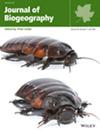Reptile Diversity Patterns Under Climate and Land Use Change Scenarios in a Subtropical Montane Landscape in Mexico
Abstract
Aim
Mountainous regions are rich in reptile biodiversity but face threats from climate and land use changes. Understanding how these factors affect reptile diversity in these regions can highlight key conservation hotspots that require effective conservation actions. Here, we explored reptile taxonomic and functional diversity patterns along the Sierra Madre del Sur region in southeast Mexico, and potential changes in future years caused by different climate and land use change scenarios.
Location
Sierra Madre del Sur, México.
Taxon
Reptiles.
Methods
We used species distribution models and information on species traits to estimate taxonomic and functional diversity throughout the Sierra Madre del Sur (SMS) region under current and future climate and land use change scenarios.
Results
Greater taxonomic and functional diversity was observed in both temperate and tropical forests. Taxonomic diversity was higher in more drier areas at high elevations while higher functional diversity was observed in wetter areas at intermediate-to-high elevations. Lower diversity for both dimensions was associated with anthropic land uses. In future scenarios, both dimensions of diversity are expected to increase in temperate forest in highlands of central Oaxaca and decrease in the southcentral portion of the SMS, particularly for the worst scenarios due to increased deforestation rates.
Main Conclusions
Higher taxonomic diversity in more drier areas at high elevations could be due to historical and evolutionary factors, while higher functional diversity in wetter areas at intermediate-to-high elevations may be explained by a higher environmental heterogeneity in forests within these conditions. Larger diversity losses in the southcentral portion of the SMS are probably due to larger predicted deforestation rates in those areas. Our results are valuable not just for informing conservation actions, such as the creation of protected natural areas but also to understand the underlying processes behind the patterns of reptile diversity.

 求助内容:
求助内容: 应助结果提醒方式:
应助结果提醒方式:


